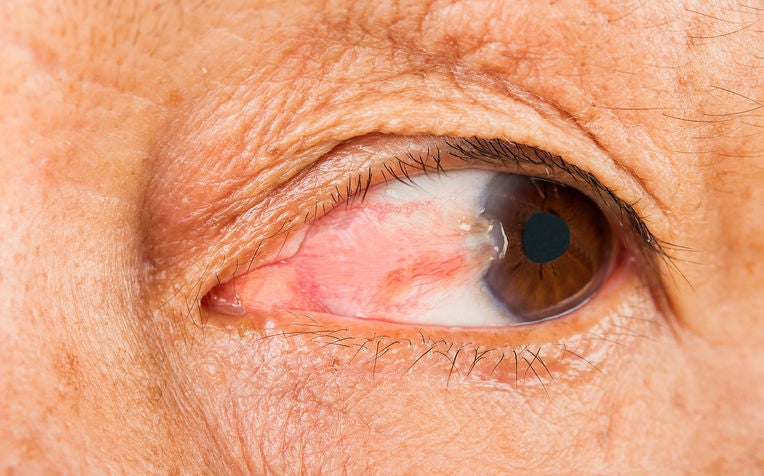
Pterygium is a reddish, triangular or wing-shaped eye growth. If left untreated, it can grow over the central cornea over time and affect vision.
Here’s another reason why you should be careful to shield your eyes from sunlight when you spend time outdoors: Prolonged exposure to ultraviolet (UV) radiation from the sun can cause an eye condition known as pterygium.
"A pterygium is a reddish, triangular or wing-shaped growth that begins from the conjunctiva, which is the thin, white layer that covers the front of the eye," explains the Corneal & External Eye Disease Department at Singapore National Eye Centre (SNEC), a member of the SingHealth group.
"In its early stages, it is mostly harmless, but with time it can grow over the cornea and affect vision," says our experts.
Although the exact causes of a pterygium remain unknown, ultraviolet (UV) rays from the sun have been shown to be a contributing factor.
"Exposure to long hours of sunlight outdoors and dry, dusty conditions seem to play an important role."
Watch the video!
Preventing pterygium: Protecting your eyes from UV light is a start
Investing in a good pair of sunglasses not only protects you from pterygium, but other eye diseases as well.
Choose carefully as some sunglasses don’t offer the right protection. Make sure the sunglasses you buy can block 100 per cent of UV light.
For more on how to choose sunglasses that are right for you, read this article.
Symptoms of pterygium
A pterygium can occur in one eye or both eyes, and one eye can sometimes be more affected than the other.
This slow-growing, non-canerous condition usually starts in the inner corner of the eye and may remain so for several years. Symptoms of pterygium include:
A whitish growth with prominent blood vessels on the inner or outer corner of the eye
Persistent redness and irritation
Dry eyes
Occasional tearing
A sensation of having a foreign body in the eye
"The pterygium can sometimes grow over the cornea, which is the central clear part of the eye," warns our specialists. A pterygium can cause changes in the round shape of the cornea through scarring, resulting in increasing astigmatism.
In advanced cases, the growth can even be large enough to reach the centre of the cornea, causing significant visual blurring.
Most times, the diagnosis of a pterygium is simple and clear-cut. Your doctor will be able to confirm the diagnosis with a simple examination of the eyes. In more advanced cases, investigative tests may have to be performed to determine the effect of the pterygium on the eye.
Treating pterygium
For a start, your ophthalmologist may prescribe eye drops and ointments to soothe any redness, discomfort and inflammation.
While this can provide some relief, it will not stop a pterygium from growing larger. How fast a pterygium grows varies from patient to patient – some can have the condition for years before the lesion is large enough to affect vision.
Generally, surgical removal is considered when a pterygium causes blurred vision or refractive errors like astigmatism. Persistent irritation and discomfort may also be an indication to have the pterygium removed.
During the surgery, the bare area left behind by the removal of the pterygium is covered with the patient’s own conjunctiva, in a procedure called conjunctival autografting. This thin, superficial tissue is taken from the same eye and attached using sutures or a special adhesive known as fibrin glue. This procedure is safe and very effective and results in a good cosmetic outcome.
A pterygium can sometimes recur after surgery, and this is why surgical removal is with conjunctival autografting is performed. Although this form of surgery is technically difficult, the risk of a pterygium growing back is very low compared to other methods, and is considered the ‘gold standard’ for pterygium removal."
At SNEC, 400 to 500 pterygium surgeries are performed each year. Pterygium excision with conjunctival autografting is the treatment of choice, performed in 97 per cent of all pterygium surgeries. With this procedure, recurrence rates are generally less than 5 percent in primary pterygia and 10 percent in recurrent pterygia.
Ref: H24
Other eye articles you may be interested in:
Dry Eyes: Home Remedies and Coping Tips
8 Easy Ways to Prevent Eye Strain
Cataract: Causes, Symptoms and Treatment
Glaucoma: Beware of the Silent Thief of Sight
AMD (Age-Related Macular Degeneration): What You Need to Know
Contributed by














 Get it on Google Play
Get it on Google Play